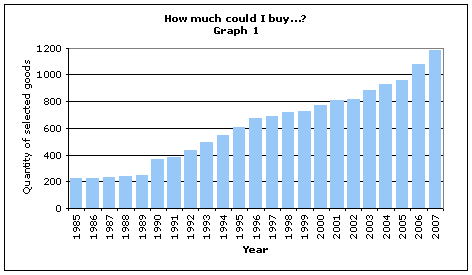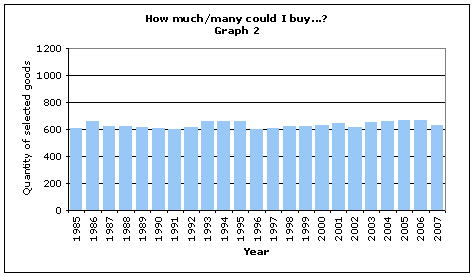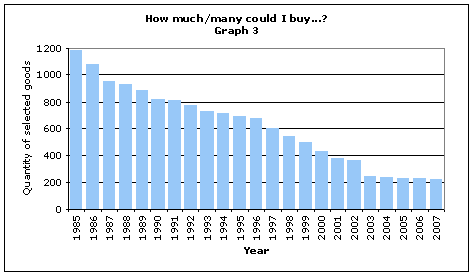Explanatory notes - How much/many could I buy
In the graph you can see how much/many pieces of selected kind of goods (or services) you could buy for the average wage or for the wage entered by you in a given year. Thus, with some simplification, you can come to the conclusion whether your standard of living improved or worsened - of course, from the point of view of the respective product.
How did we come to such information? Simply by dividing the wage (average gross monthly wage) by the price of the chosen product or service. Then the graph shows how this number developed in particular years and how many pieces, litres or kilograms it was possible to buy for a given wage. With some simplification you can come to the conclusion whether you live better or worse, how your standard of living has changed.
Was this figure increasing during the last years as in the Graph 1?

Well done, then the standard of living grew, measured by the possibility to buy the respective product. Of course, it does not mean the price of product had to stagnate and the average wage had to grow by high speed - to this conclusion we can also come otherwise: e.g., both wage and price grew, but the wage more quickly.
If you can buy always the same quantity of product or service, then your standard of living does not change.
See Graph 2.

Although it does not seem so at the first sight, the prices and wages used in this example could move, too. But it must be movement with the same speed and in the same direction. In case the prices and wages grow with the same speed, the possibility to buy the chosen product or service does not change.
Or the number of products or services you could buy for your wage was dropping? This happens, too; the life does not bring only joy.

Try another product; maybe you would turn out well. Or you have underestimated your earnings - try to change the setting. How much would you have to earn to be able to buy the same number of pieces all the time? It is possible to test it on a model. Many people may oppose that it is not possible to buy something for gross wage, that it is necessary to deal only with the net wage. Of course, they are right. But from statistical data it is not easy to learn the net wage. Surely you realize that the shoes you bought in 1985 differed from those offered in shops now - you are right again, so do not forget to read our explanations of the individual commodities, in which we tried to describe these differences. Everything has its difficulty and fault on beauty. But why - at least on a model - not play with numbers?










